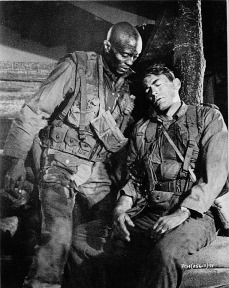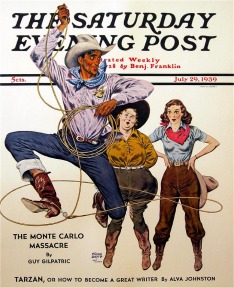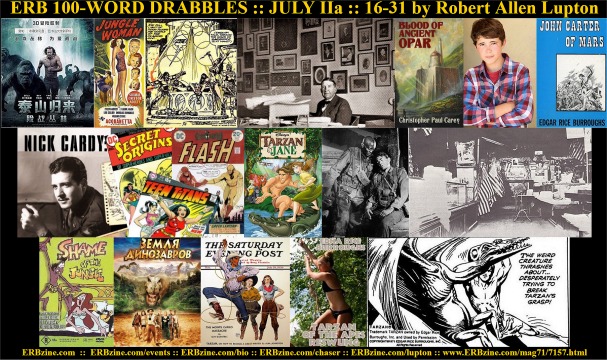
Official Edgar Rice Burroughs Tribute and Weekly Webzine Site Since 1996 ~ Over 15,000 Webpages in Archive Volume 7157a 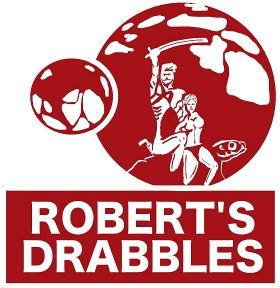 |
ERB 100-Word Drabbles
JULY IIa Edition :: Days 16 - 31
See Days 1 - 15 at ERBzine 7157
by Robert Allen Lupton
With Collations, Web Page Layout and ERBzine Illustrations and References by Bill Hillman
July 16: On this day in 2000, Jonathan Morgan Heit, who shared the credit with Craig Garner for voicing the four year old Tarzan in the Constantin motion-capture film, “Tarzan,” was born. (Kellan Lutz voiced the adult Tarzan and Anton Zetterhorn voiced the teenaged Tarzan.) Four Tarzans is a lot for one film. Spencer Locke voiced Jane.
Heit is best known for his role in the Adam Sandler film, “Bedtime Stories.” Heit appeared on “General Hospital,” “ER,” “Monk,” “How I Met Your Mother,” “Rules of Engagement,” ‘Family Guy,” and “Granite Falls.” He voiced the character, “Cubby,” on 90 episodes of “Jake and the Never Land Pirates.”
Today’s drabble is “It’s Called Acting” is today’s 100 word Edgar Rice Burroughs inspired drabble.
IT'S CALLED ACTING
![]()
Jonathan Morgan Heit answered with a deep rumble. “That’s not my real voice. It’s called acting. I’m twelve, not four. I do several voices. You sound like a pouty teenager.”
“Like you said, I’m not pouting. It’s called acting.
Next year, I’ll play Tarzan on stage in Hamburg.”
“Right then. You don’t tease me and I won’t tease
you. My voice isn’t squeaky and yours doesn’t sound like a crybaby.”
‘Agreed, it’s just the way we’re written.”
“Kreegah.”
“Bundolo.”

ADVERTISING DILEMMA
July 17: On this day in 1921, Mildred Davenport was born in Ozone, Wyoming. Sometimes her birth city is identified as Cheyanne, Wyoming. Known professionally as Aquanetta, Mildred appeared in several jungle themed motion pictures. She was nicknamed the "Venezualan Volcano" by Universal Studios.
Acquanetta claimed she was born Burnu Acquanetta, meaning "Burning Fire/Deep Water", in Ozone, Wyoming. Orphaned from her Arapaho parents when she was two (or three), she lived briefly with another family before being taken in by an artistic couple with whom she remained until she made the choice to live independently at the age of fifteen.
In 1942, “LIFE” magazine noted her mysterious origins, stating that Acquanetta was actually born Mildred Davenport to African American parents in Newberry, South Carolina in 1921 and reported that she had lived with a Spanish family in Spanish Harlem posing as a Venezuelan before moving to Mexico, then Venezuela to obtain citizenship. The article suggests that the Arapaho orphan story was invented because she was unable to produce any identification for the Screen Actors Guild. I make no representation concerning the accuracy of the “Life” article or any other version of any story concerning her birth and childhood.
She starred in “Tarzan and the Leopard Woman” (1946) and also had roles in “Arabian Nights” (1942), “Jungle Woman” (1944), ‘Captive Wild Women (1943),“Dead Man's Eyes” (1944), “Lost Continent “(1951), and “The Legend of Grizzly Adams” (1990).
Her career ended abruptly. One version as to why Mildred left Universal Studios with seven years left on her contract is quite scandalous. Screenwriter Ed Hartman claimed that Universal learned (or came to believe) that Mildred was African American. Word about Mildred’s ethnicity was relayed to the producers. After the alleged news about Mildred’s ethnicity surfaced, the studio dropped her. If Hartman was correct, it’s a sad commentary on the rampant racism in Hollywood at that time. I don’t know which story, if any, is correct. I just sorry she didn’t make more films.
Mildred married a millionaire car dealer in Phoenix and had her own local television show, “Acqua’s Corner,” that ran for many years.
“Advertising Dilemma” is today’s Acquanetta and Aqua Net inspired drabble.
ADVERTISING DILEMMA
![]()
“Hairspray.”
“I’m not sure we can register ‘hairspray’ as a trademark.”
“Maybe we could call it Hair-Hold.”
“That’s stupider than Hair-Glue.”
“Women sometimes wear hair nets. We could call it Spray-net.”
“Sounds like an insecticide. We put lots of water in it. How about Water Net or Aqua Net.”
“Wasn’t there an actress named Aquanetta?”
“Yes, there was. We could hire her to do the commercials.”
“I already signed the Three Stooges.”
“You think women will want hair like Moe or Larry?”
‘To quote Curly, ‘You’re getting’ on my nerves.”
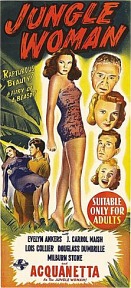
YOU WON'T LIKE ME WHEN I'M JEALOUS
July 18: On this day in 1981, Mike Grell's "Return to Opar," written and illustrated by Mike, began on the Tarzan Sunday pages. The story ran for 10 weeks. Grell took over the Sunday comic from Gil Kane and Archie Goodwin with “Return to Opar,” and continued to write and draw the Sunday pages until February 27, 1983 – except for one Sunday, February 13, 1983, which was written and drawn by Thomas Yeates.
The entire 10 page run is available at:
https://www.erbzine.com/mag29/2968.html
The first three episodes of ½ page Tarzan Sundays tell of Tarzan saving a photojournalist, Jessica Faraday, from a bull gorilla. Faraday, guided by the poacher, Tusker Shanks, arrives in Opar. She is captured. La is enamored by Shanks and plans to sacrifice Jessica to the sun god. Shanks believes that he will become an Oparian god, or at least, a king. Tarzan intervenes and rescues Jessica, leaving Shanks to take her place on the sacrificial altar.
The story emphasizes La’s fascination with men from outside of Opar and her anger at being jilted. It’s a bad thing when ‘the woman scorned’ has an altar and a sacrificial knife.
“You Won’t Like Me When I’m Jealous” is today’s Edgar Rice Burroughs inspired drabble.
YOU WON'T LIKE ME WHEN I'M JEALOUS
![]()
“In Opar, modern rules don’t apply. La’s word is law. Her altar is stained with blood from countless victims. I’ve escaped before and I can again.”
“What about Shanks? He’s evil and should be punished.”
“The Oparian gods thirst for blood and justice. La’s
love and her altar have altered the life of many evil men. Shanks is no
exception.”
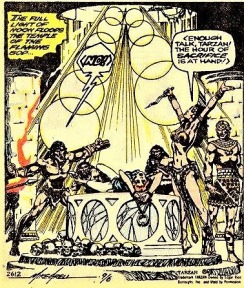
BOX OFFICE SEASON
July 19: On this day in 2016, "The Legend of Tarzan," was released in China. This was unusual because China doesn't normally allow foreign films to be released there in the month of July. In theory, this gives Chinese produced films a better chance to succeed. No competition. An exception was made for "The Legend of Tarzan."
The new Tarzan movie made $7 million on opening day and went on to deliver a six-day opening of around $27 million and a three-day opening weekend of $12 million.
“Box Office Season” is today’s Edgar Rice Burroughs inspired drabble.
BOX OFFICE SEASON
![]()
Jian shook his head. “We don’t permit capitalist films to open during high box office season?”
“Well, we’ve millions invested in the film.”
“That’s nothing new. The film must wait until fall.”
“No, Jian, we’ll let it open in July. Edgar Rice Burroughs treated us honorably in his novels.”
“Why on Earth would you believe that?”
“He predicted that China would rule the world in his novel, “Beyond Thirty.”
“He also wrote a story where the world was conquered by Moon Men.”
“Have patience, Jian. There’s still time.”

CHAMPAGNE AND ARTICHOKES
July 20: On this day in 1940, a short biography of ERB appeared in Bob Davis' “New York Sun” column. Davis, had retired from Munsey's and lived at Kailua, Hawaii. He and Burroughs ran into each other, Davis interviewed him, and the result was published in “The New York Sun.”
Bob Davis was an early editor of pulp magazines. He appreciated and acquired a number of ERB stories for the magazines he edited. Davis was the Munsey's editor responsible for the publication of ERB's first story: “Under the Moons of Mars” (“A Princess of Mars”). He also published a little story called “Tarzan of the Apes” in All-Story magazine. A little thanks and a tip of the hat to Mr. Davis.
Read the entire interview at:
https://www.erbzine.com/mag33/3365.html
Today’s drabble is “Champagne and Artichokes,” and it’s taken from that interview.
CHAMPAGNE AND ARTICHOKES
![]()
I was not much of a juvenile, at least, not in the sense of bright qualities disclosed only to relatives. My boyhood was one swift leap from the cradle to early youth, eventless. Sort of a blackout intellectually, with no lofty yearnings, just a boy.
Don’t forget that I hate artichokes, and you might add custard apples, which I haven't even so much as tasted.
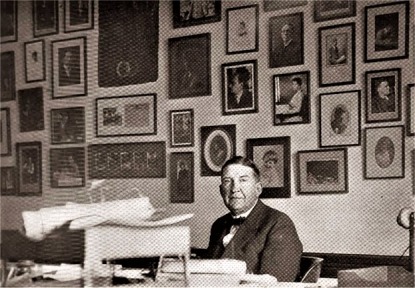
BY ANY OTHER NAME
July 21: On this day in 2016, Meteor House Press published “Blood of Ancient Opar,” by Christopher Paul Carey. The epic saga of Khokarsa continues in Blood of Ancient Opar, a brand-new sequel novella to Hadon, King of Opar by Christopher Paul Carey, chronicling Hadon’s further adventures in the fallen empire’s last remaining queendom. Using Philip Jose Farmer’s own notes, Carey at last fills in the missing history of a civilization lost to the mists of time. The publication was limited to 175 signed hardcovers and 175 signed paperbacks.
This wonderful book is one in a series of books based on Edgar Rice Burroughs’ lost city of Opar, only the Opar of years ago. ‘Blood of Ancient Opar” is the fifth book in this series, not counting two prequels, “Time’s Last Gift” and “Exiles of Kho.”
An electronic edition of the book is available in Amazon.com
“By Any Other Name” is today’s Edgar Rice Burroughs, Philip Jose Farmer and Christopher Paul Carey inspired drabble.
BY ANY OTHER NAME
![]()
“Pat, that’s not right. Pay attention. Tarzan was John
Gribardsun.”
“Didn’t he change his name to be one of the ancient
Oparians? Maybe Tarzan was the original Flaming God.”
“And you’re a flaming idiot. You think La planned
to sacrifice Tarzan to himself.”
“No, so which character was really Tarzan.”
“There’s no straight answer. You must decide for yourself.
That’s the beauty of it.”
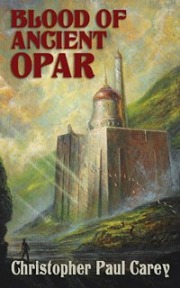
LIFE'S TOO SHORT TO DRINK BAD WHISKEY
July 22: On this day in 1950, the last Tarzan daily strip to include work by Nick Cardy appeared in newspapers across the country. The storyline, “Tarzan and Hard-Luck Harrigan,” was also illustrated by Burne Hogarth. Cardy had taken over “Tarzan and the City of Gold on February 13, 1950 and his work appeared in the next 84 installments of that story, as well as the first 54 installments of “Hard-Luck Harrigan” before the story was turned over to Bob Lubbers and Burne Hogarth. Cardy’s 138 days is one of the shortest tenures on the daily comic.
Nicholas Viscardi (Cardy) went on to illustrate “Aquaman,” “Tomahawk,” “Teen Titans,” and “Batlash.” He drew countless covers for about every title that DC Comics published. In the mid-1970s, Cardy left comics for commercial art – where he used the name ‘Nick Cardi,’ and drew magazine art and advertisements. He drew the one sheet movie poster for Neil Simon’s “California Suite” in 1978.
Viscardi also earned two Purple Hearts for wounds suffered as a tank driver while serving with the 3rd Armored Division in WWII. We thank him for his service.
“Life’s too Short to Drink Bad Whiskey” is today’s Edgar Rice Burroughs and Nick Cardy inspired drabble.
LIFE'S TOO SHORT TO DRINK BAD WHISKEY
![]()
Harrigan mumbled softly. “I’ll capture the wild-man
and sell him to a circus. I’ll be rich.”
He offered food and made threats. Neither worked.
He gave Tarzan snake-oil elixir (cheap whiskey) to drink. Tarzan spit out
the vile liquor. “This is disgusting. Why would you give it to me?”
Harrigan said, “I always offers whiskey to my friends.”
“If this is how you treat your friends, I’m thankful
I’m not your enemy.”
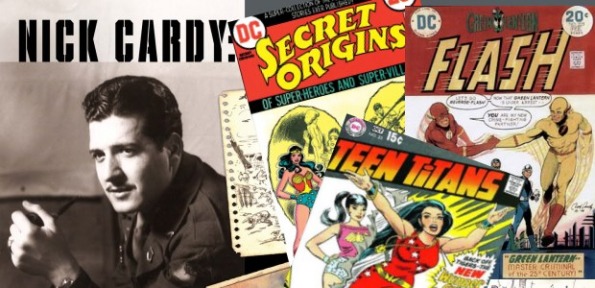
JUNGLE ANNIVERSARY
July 23: On this day in 2002, Disney released “Tarzan and Jane.” Tarzan & Jane is an animated comedy-adventure film produced by Walt Disney Television Animation with the original animation production by Toon City, Walt Disney Animation Australia, Wang Film Productions and Hana Animation. Released on July 23, 2002, it is a direct-to-video sequel to the Disney's 1999 animated feature “Tarzan,” and uses three unaired episodes of the film's corresponding television series, “The Legend of Tarzan. Tarzan II.” The film is set one year after the events of the first film.
The film makes uses a frame tale format to present three self-contained "episodes" via flashback. Jane and Tarzan's first wedding anniversary has arrived, and Jane is trying to find a suitable present for her husband, with the help of the elephant Tantor and the gorilla Terk.
Michael T. Weiss voiced Tarzan, Olivia d-Abo voiced Jane, and April Winchell voiced Terk. Nicolette Sheridan, who starred in Desperate Housewives and Knots Landing voiced Eleanor, one of Jane’s upper crust British friends. She also appeared with Carol Burnett and Michael Caine in the comedy film, “Noises Off,” adapted from one of the best stage plays ever.
“Jungle Anniversary” is today’s Edgar Rice Burroughs inspired drabble.
JUNGLE ANNIVERSARY
![]()
“He hated jewelry and formal clothes. He’s happy wearing a knife and loin cloth.”
“What should I do?”
“Tarzan’s happy when other people are happy.”
Terk led Jane inside where Tarzan surprised Jane with an anniversary party.”
Jane said, “Is there cake? There should be cake.”
Terk presented the cake she’d made. Something under the frosting moved. Jane flinched “The cake’s alive!”
" It contains cassava, honey, berries, ants, beetles, and termites.”
“Disgusting. Does this vile concoction have a name?”
The ape smiled. “I call it Terkish Delight.”
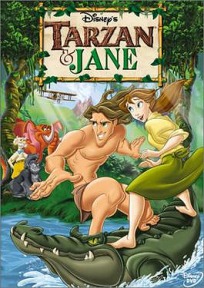
WRITING CREDIT
July 24: On this day in 1964, Canaveral Press published the first edition of “John Carter of Mars.” The 208 page book contains two stories, “John Carter and the Giant of Mars (authorship usually attributed to John Coleman Burroughs) and “Skeleton Men of Jupiter.”
Some sources say that Edgar Rice Burroughs and his son, John Coleman Burroughs, collaborated on “Giant of Mars.” I like to think so, but who knows. There are inconsistencies in the story when compared to the other books in the series – three legged rats (not ulsios) and radium pistols are now called atomic guns. Flyers are now called airplanes or aircraft. Parachutes and radios appear for the first time on Barsoom and the book is written in the third person, instead of first person – John Carter.
Here are two ERBzine articles that have opinions of the subject of authorship:
By Del Valdon: https://www.erbzine.com/mag15/1507.html
The dust jacket and eight interior illustrations were by Reed Crandall. The book is 208 pages long. Ballantine reprinted the book in paperback with three separate covers by Robert Abbett, Gino D’Achille, and Michael Whelan. The Science Fiction Book Club reprinted it in April 1967 in a combined volume with “Llana of Gathol.”
“Writing Credit” is today’s Edgar Rice Burroughs inspired drabble.
WRITING CREDIT
![]()
“Giant of Mars” didn’t feel right. Too many new creatures. Different technology. The Giant was 130 feet tall, taller than the sphinx. I don’t think Burroughs wrote the story.”
“It says Edgar Rice Burroughs on the cover.”
“I still don’t think he wrote it.”
“John, you sound like the literature professor who
insisted that Homer didn’t write the “Odyssey,’ but it was written by another
man with the same name.”
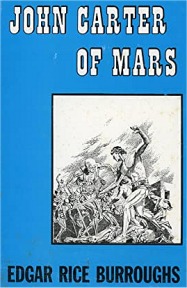
ACTING AGAINST TYPE
July 25: On this day in 1914, Woodrow Wilson Woolwine Strode was born in Los Angeles, California. He was a decathlete and football star who was one of the first Black American players in the National Football League in the postwar era. After football, he went on to become a film actor, where he was nominated for a Golden Globe Award for Best Supporting Actor for his role in Spartacus in 1960. He served in the United States Army Air Corps during World War
After his football career and a brief period as a professional wrestler, Woody Strode turned to acting. He appeared in “The Lion Hunters,’ a Bomba, the Jungle Boy movie, “Bride of the Gorilla,” several episodes of “Rama of the Jungle,” “Demetrius and the Gladiators,” the Jungle Jim film, “Jungel Man-Eaters,” and “Son of Sinbad.” He appeared in the “The Ten Commandments” and in 1958 had a small part in “Tarzan’s fight For Life.” In 1963, he was cast opposite Jock Mahoney in “Tarzan’s Three Challenges,” playing two roles. He appeared in several episodes of the Ron Ely Tarzan television series.
His first wife was Princess Luukialuana Kalaeloa (a.k.a. Luana Strode), a distant relative of Liliuokalani, the last queen of Hawaii. They were married until her death in 1980.
“Acting Against Type” is today’s Edgar Rice Burroughs and Woody Strode inspired drabble.
ACTING AGAINST TYPE
![]()
“They’re all similar. In the Air Force I loaded bombs, sometimes in Hollywood, I acted in a bomb.”
“Some people were upset when you married a real life Hawaiian princess.”
“Jealousy. I’m not responsible for some people’s opinions. People told John Ford not to cast me against type as a semi-coward in “Port Chop Hill.” Ford said the only question was ‘Would he take it in stride? If you’ve seen the film, you know I did.”
I'M A WRITER, NOT A MERCHANT
July 26: On this date in 2011, The Pocatello Journal published “The Amazing Story of Edgar Rice Burroughs in Pocatello” by Albert Strickland. The article coincided with 2011 Dum Dum that was held in Pocatello Idaho.
https://www.erbzine.com/idaho/news.html
The article explained that ERB lived in Pocatello from June of 1898 to January 1899. He didn’t make it through a single winter. I don’t think I would have either. He owned and operated a newspaper and dry goods store at 233 West Center Street. His favorite saloon was the Q P Saloon located just down the street at 301 West Center where a man could get a Porterhouse Steak for 35 cents.
He ordered a supply of leaflets for the store. He wrote part of “Minidoka,” on the back of those leaflets. He had the sense to save the story, even though it wouldn’t see print until 1998.
The drabble for today, “I’m a Writer, not a Merchant,” was written by Mr. Strickland and is excerpted from his article.
I'M A WRITER, NOT A MERCHANT
![]()
Edgar sold the store back to Victor Roeder and later wrote "God never intended me to be a retail merchant."
The photo is of the interior of ERB’s store in Pocatello. The dictionary stand is located in the ERB Inc. offices.
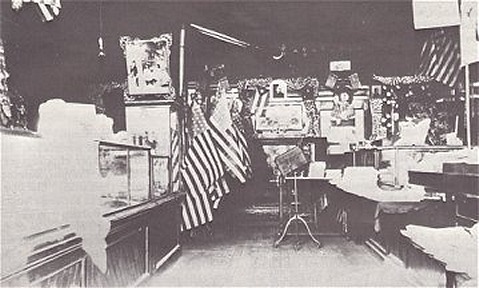
SINK OR SWIM
July 27: On this day in 2006, Johnny Weissmuller Junior died of liver cancer.
Weissmuller's mother was Beryl Scott, the third of his father's five wives. He was born in San Francisco, where his father was performing at the Golden Gate International Exposition in a water ballet show called Billy Rose's Aquacade. The younger Weissmuller graduated from the University of Southern California in Los Angeles, where he was on the swim team. He joined the United States Navy, using his swimming acumen to specialize in underwater demolition.
In 1958, Weissmuller Jr. got his first screen role in the Mickey Rooney film “Andy Hardy Comes Home”. His subsequent credits include parts in “THX 1138” (1971) and the 1973 hit “American Graffiti” (as Bad Ass #1). He also provided the voice of the Tarzan character in the English language version of the X-rated cartoon, Tarzoon: Shame of the Jungle (1975). His last movie role was as a bounty hunter in the 1988 release “Wildfire.” Weissmuller Jr. also appeared as a guest star in two episodes of “The Streets of San Francisco.” In 1961, he appeared in the episode "The Four" with Jack Elam in the western series, “Lawman,” starring John Russell.
He recorded and marketed a set of four cassettes in a wooden box, with the title "Tarzan" and the subtitle "Original Stories by Edgar Rice Burroughs." The box states the tapes are "Performed by Johnny Weissmuller Jr." and the tapes themselves say "Directed by Johnny Weissmuller Jr." The stories on the tapes, somewhat abridged, are "Tarzan of the Apes," "The Return of Tarzan," "Tarzan and the Jewels of Opar," and "Tarzan and the City of Gold."
Weissmuller Jr.'s memoir, “Tarzan, My Father,” was published in 2002 by ECW Press in Toronto, Ontario.
The illustration for “Tarzoon” is the most G-rated one I could find.
“Sink or Swim” is today’s Edgar Rice Burroughs and Johnny Weissmulller Jr. inspired drabble.
SINK OR SWIM
![]()
“Sir, that would be me, sir.”
“You fancy yourself Tarzan, do you?”
“No, sir. That would be my dad. He’s Tarzan.”
“Well, Daddy ain’t here. You can swim, can’t you?”
“Dad taught me to swim. I wasn’t as fast as him, but
who is. I was on the swim team at the University of Southern California.”
“How long you think you can stay afloat, jungle boy.”
“Longer than you can stay awake and watch me”
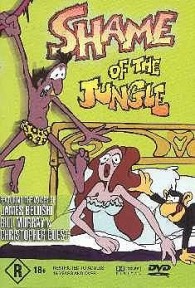
DEMOTION
July 28: On this day in 2009, the direct-to-video film, “The Land That Time Forgot,” was released. The film was produced by the independent American film studio, The Asylum. The film was promotionally titled, “Edgar Rice Burroughs’ The Land That Time Forgot.” It was released in other countries as “Dinosaur Island.”
All of the character’s names were changed from the names used in the Edgar Rice Burroughs novel. For example, Timothy Bottoms plays Captain Burroughs. C. Thomas Howell directed and played Frost Michaels (Bowen Tyler). The island is still called Caprona. I was confused about why the characters names were changed, but then I realized after watching the film, that the names were changed for the same reason names were changed on the old Dragnet television show – to protect the innocent.
The 90 minute masterpiece was filmed on a total budget of $600,000.00.
The poster reproduced with this article is a Russian poster for the video.
“Demotion” is today’s Edgar Rice Burroughs inspired drabble.
DEMOTION
![]()
Director Thomas Howell said, “It’s a tribute, like
when Stan Lee appears in all the Marvel movies.”
“They don’t change the characters’ names in the Marvel
movies.”
“Burroughs should be honored to be a captain.”
“Really. He was a major in the Illinois militia. I
doubt that he’d appreciate the demotion.”
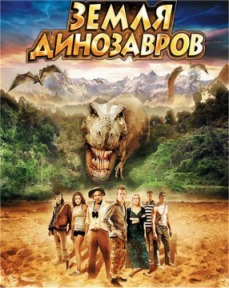
WHAT MAKES A GREAT WRITER
July 29: On this day in 1939, the article, “Tarzan, Or How To Become a Great Author,” appeared in the Saturday Evening Post. The Article was written by Alva Johnson. In the article, Burroughs credits himself with only a single stroke of genius (or being a great writer) and that is the naming of Tarzan. In the original manuscript, he used the names, Zantar, and Tublat Zan.
Thank goodness he made the change. Tublat Zan sounds like the name of a minor warlord riding with Genghis Khan and Zantar just doesn’t have that ring.” Zantar of the Apes” doesn’t work for me.
However, Wizard 101 Wiki, an online gaming site, has a quest called, “Zantar of the Gorillas,” a novel idea.
The entire Saturday Evening Post article is available to read at: https://www.erbzine.com/mag5/0527.html.
The cover of the issue was drawn by Floyd Davis. The ERB article is mentioned on the cover.
Today’s drabble, “What Makes A Great Writer,” was written by Alva Johnson.
WHAT MAKES A GREAT WRITER
![]()
These tests are: The size of the writer's public. His success in establishing a character in the consciousness of the world. The probability of his being read by posterity.
Judged by these tests, Edgar Rice Burroughs is first and the rest nowhere.”
IN THE BEGINNING
July 30: On this day in 2010, Jekkara Press published the Ebook, “Tarzan of the Apes Reswung.” The 87,880 word novel is credited to Edna Rice Burroughs.
I haven’t changed the spelling or the punctuation in the blurb for the novel. “A Tarzyn the Apewoman story. Joan Clayton and her husband die, stranded in Africa. Their young daughter is taken in by a band of smarter apes. Raised to adulthood by her beast family, she becomes Tarzyn the Apewoman, one of the greatest heroes the world has ever known. Teaching herself from her parents belongings, she finds love in the arms of Jan Porter. A Gender Switch Adventure.”
Edna Rice Burroughs is credited with three other gender switch novels. “A Princess of Mars Rethroned,” “The Gods of Mars Revoked,” and “Warlord of Mars Embattled.” The books aren’t for sale anywhere, but all four books are free to download in Ebook or mobi formats .
The photo of Edna Rice Burroughs on the smashwords website is a black and white photo of a young Asian woman. No other information about her is provided.
Today's drabble, "In the Beginning," is the first 100 words of Edna Rice Burroughs’ Tarzan novel. If you compare her first 100 words to the first 100 words in the first edition of “Tarzan of the Apes,” you find that they are identical except for some gender specific pronouns. The rest of the book is the same with very few exceptions.
IN THE BEGINNING
When my convivial host discovered that she had told me so much, and that I was prone to doubtfulness, her foolish pride assumed the task the old vintage had commenced, and so she unearthed written evidence in the form of a musty manuscript, and dry official …”

July 31: On this day 49 years ago the Russ Manning written and drawn Tarzan Daily Comic strip story, “Tarzan and the Cult of the Mahars,” concluded after a run of 122 days. The entire strip can be read in its entirety at https://www.erbzine.com/mag29/2916.html
The Tarzan Daily comic ended 363 days later after the last two story lines concluded. “Korak and the White Water Runners” followed “Cult of the Mahars.” The last Tarzan daily comic story was “Tarzan Returns to the Earth’s Core.”
Manning drew and wrote the strip from December 11, 1967 until July 29, 1972. His work is some of the best written and illustrated daily comics every published.
“Who’s a Pet” is today’s Edgar Rice Burroughs inspired drabble.
WHO'S A PET
![]()
“A captive mahar, you say. How do they use it?”
“It makes people surrender to them. People believe
that it’s a god. The cult gets bigger every day. You have to stop the priests.”
“Jane, if there’s a mahar, the priest’s only think
that they’re in charge. The mahar is really in control.”
“You believe that?”
“Of course. Nothing gives a despot more power than
allowing his minions believe they’re in charge.”
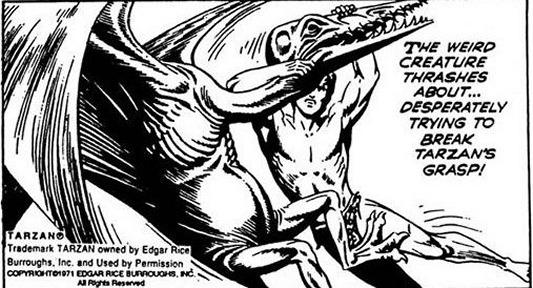
![]()
See Days 1-15 at ERBzine 7157
![]()
JULY IIa ILLUSTRATIONS COLLAGE
![]()
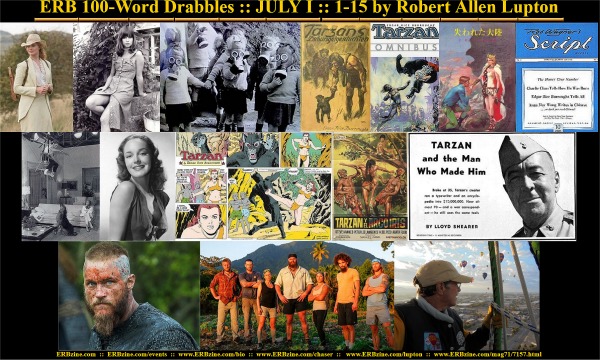
Click for full-size promo collage
